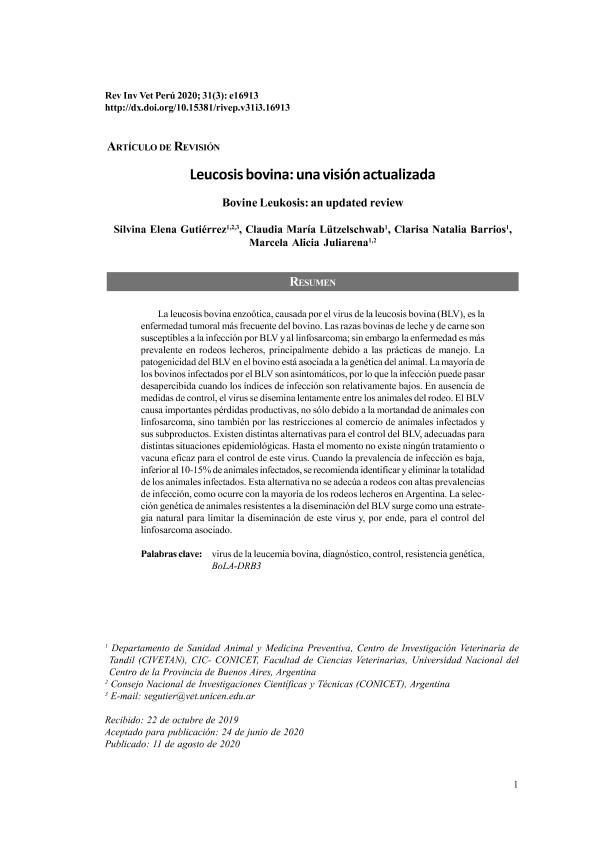Artículo
La leucosis bovina enzoótica, causada por el virus de la leucosis bovina (BLV), y es la enfermedad tumoral más frecuente del bovino. Las razas bovinas de leche y de carne son susceptibles a la infección por BLV y al linfosarcoma; sin embargo la enfermedad es más prevalente en rodeos lecheros, principalmente debido a las prácticas de manejo. La patogenicidad del BLV en el bovino está asociada a la genética del animal. La mayoría de los bovinos infectados por el BLV son asintomáticos, por lo que la infección puede pasar desapercibida cuando los índices de infección son relativamente bajos. En ausencia de medidas de control, el virus se disemina lentamente entre los animales del rodeo. El BLV causa importantes pérdidas productivas, no sólo debido a la mortandad de animales con linfosarcoma, sino también por las restricciones al comercio de animales infectados y sus subproductos. Existen distintas alternativas para el control del BLV, adecuadas para distintas situaciones epidemiológicas. Hasta el momento no existe ningún tratamiento o vacuna eficaz para el control de este virus. Cuando la prevalencia de infección es baja, inferior al 10-15% de animales infectados, se recomienda identificar y eliminar la totalidad de los animales infectados. Esta alternativa no se adecúa a rodeos con altas prevalencias de infección, como ocurre con la mayoría de los rodeos lecheros en Argentina. La selección genética de animales resistentes a la diseminación delBLV surge como una estrategia natural para limitar la diseminación de este virus y, por ende, para el control del linfosarcoma asociado. Enzootic bovine leukosis, caused by bovine leukaemia virus (BLV), is the most frequent neoplasm in dairy cattle. Both dairy and beef cattle are susceptible to BLV infection and BLV-associated lymphosarcoma. However, the disease is more prevalent in dairy herds, mostly because of the management practices in dairy farms. The pathogenicity of BLV in cattle is associated with the genetic background of the animal. Most BLV-infected cattle are asymptomatic; hence infection may be overlooked when infection rates are relatively low. BLV spreads slowly and silently when control measures are not undertaken. BLV causes important economic losses, not only because of the death of animals with lymphosarcoma but also because of restrictions in the trade of infected animals and their by-products. Different strategies to control the virus have been attempted, each for the different epidemiologic situations. At present, no treatment or vaccine has proven effective for the control of BLV. When the prevalence of infection is low, below 10 to 15% of infected animals, it is recommended to identify and cull the totality of infected cattle. This approach is not suitable for herds with high prevalence of infection, as is the case of most dairy herds in Argentina. The genetic selection of resistant animals emerges as a natural approach for the containment of BLV dissemination, and thereby, for the control of lymphosarcoma.
Leucosis bovina: una visión actualizada
Título:
Bovine leukosis: an updated review
Gutiérrez, Silvina Elena ; Lützelschwab, Claudia María; Barrios, Clarisa Natalia
; Lützelschwab, Claudia María; Barrios, Clarisa Natalia ; Juliarena, Marcela Alicia
; Juliarena, Marcela Alicia
 ; Lützelschwab, Claudia María; Barrios, Clarisa Natalia
; Lützelschwab, Claudia María; Barrios, Clarisa Natalia ; Juliarena, Marcela Alicia
; Juliarena, Marcela Alicia
Fecha de publicación:
08/2020
Editorial:
Universidad Nacional Mayor de San Marcos. Facultad de Medicina Veterinaria.
Revista:
Revista de Investigaciones Veterinarias del Perú
ISSN:
1609-9117
e-ISSN:
1682-3419
Idioma:
Español
Tipo de recurso:
Artículo publicado
Clasificación temática:
Resumen
Archivos asociados
Licencia
Identificadores
Colecciones
Articulos(CIVETAN)
Articulos de CENTRO DE INVESTIGACION VETERINARIA DE TANDIL
Articulos de CENTRO DE INVESTIGACION VETERINARIA DE TANDIL
Citación
Gutiérrez, Silvina Elena; Lützelschwab, Claudia María; Barrios, Clarisa Natalia; Juliarena, Marcela Alicia; Leucosis bovina: una visión actualizada; Universidad Nacional Mayor de San Marcos. Facultad de Medicina Veterinaria.; Revista de Investigaciones Veterinarias del Perú; 31; 3; 8-2020; 1-28
Compartir
Altmétricas



